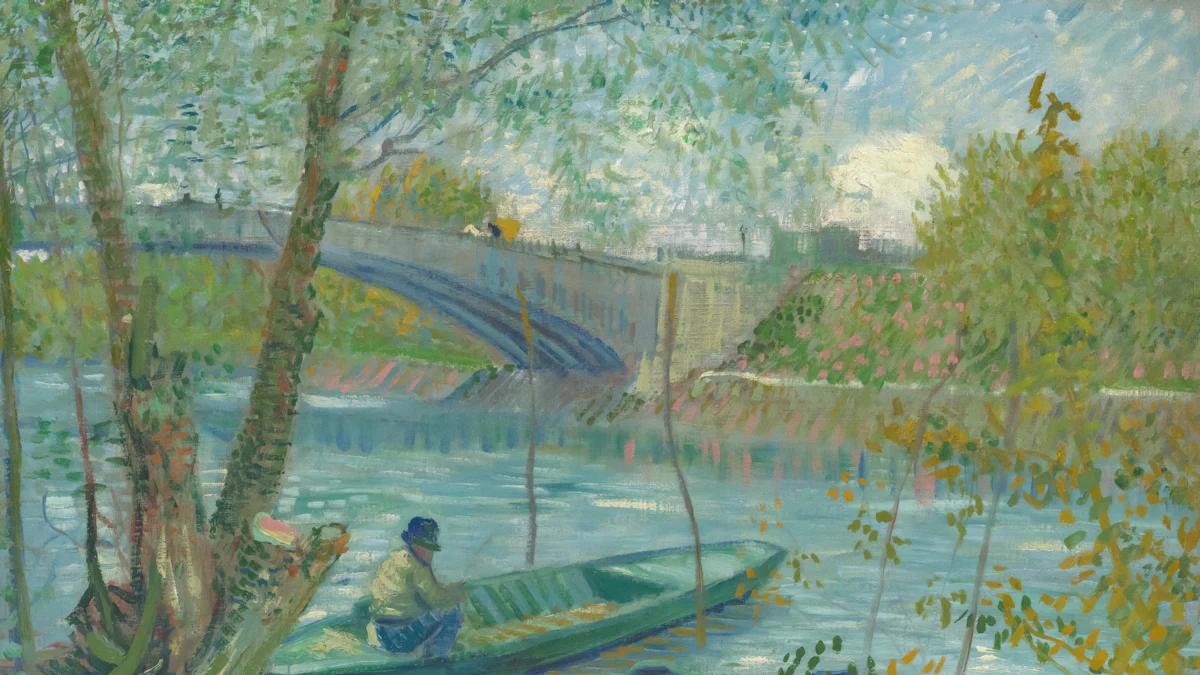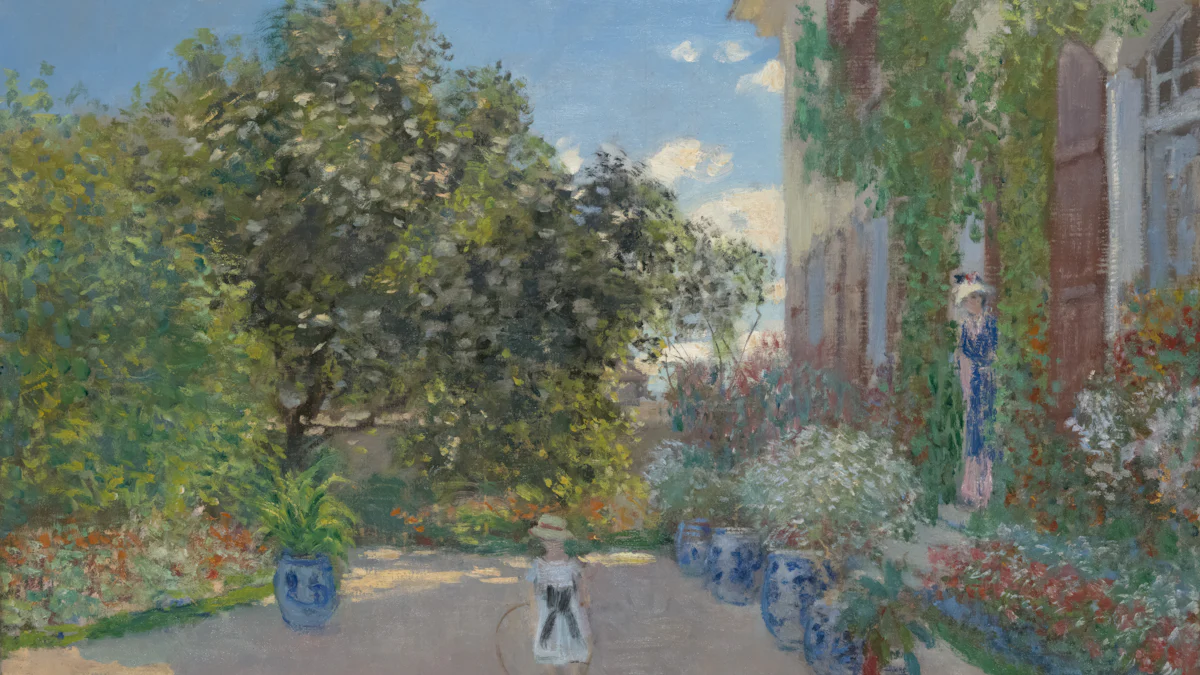Monet. The Triumph of Impressionism

Claude Monet holds a significant place in the art world. Monet's paintings have fetched prices as high as $110.7 million at auctions, showcasing his enduring value. Monet's dedication to capturing light on canvas sets him apart. The pursuit of light in his work aligns Monet with J. M. Turner, another master of this technique. Monet's approach to painting revolutionized the perception of color and light. Monet's influence extends beyond Impressionism, impacting modern art and artists today.
Early Life and Influences
Childhood and Education

Family Background
Claude Monet was born in Paris in 1840. His family moved to Le Havre when he was young. Monet's father worked as a grocer, while his mother supported his artistic interests. Monet's family provided a stable environment that allowed him to explore his creativity.
Early Artistic Interests
Monet showed an early interest in drawing. He often sketched caricatures of people around him. Monet's talent caught the attention of local artists. Eugène Boudin, a landscape painter, became his mentor. Boudin introduced Monet to painting outdoors, which later became a hallmark of his style.
Influences from Japanese Prints
Introduction to Japanese Art
Monet discovered Japanese art during the 19th century. The fascination with Japanese woodblock prints spread across Europe. Monet collected many of these prints. The vibrant colors and unique compositions captivated him.
Impact on Monet's Style
Japanese art greatly influenced Monet's style. The use of sparkling blues and burning oranges became prominent in his work. Monet's Water Lilies series drew direct inspiration from Japanese aesthetics. The focus on light and reflection mirrored the techniques seen in Japanese prints.
Experiences in Algeria
Military Service
Monet served in the military in Algeria in 1861. The experience exposed him to new landscapes and cultures. The bright Algerian light left a lasting impression on Monet. The vivid colors and contrasts influenced his future paintings.
Artistic Inspirations
Algeria provided Monet with fresh artistic inspiration. The landscapes and light differed from those in France. Monet absorbed these elements into his work. The experience enriched his understanding of color and light, shaping his artistic vision.
Development of Impressionism

Founding of the Impressionist Movement
Claude Monet played a pivotal role in the founding of the Impressionist movement. Monet, along with other artists, sought to break away from the rigid rules of academic-style painting. The desire to capture modern life and the fleeting effects of light and color drove Monet and his contemporaries. These artists organized independent exhibitions to showcase their innovative works. Monet and others founded the Société anonyme des artistes peintres, sculpteurs et graveurs. This group provided a platform for artists to present their work outside traditional salons.
Key Characteristics
Impressionism introduced several key characteristics that set it apart from previous art movements. Artists like Monet focused on open compositions and accurate depictions of light. Small but visible brushstrokes became a hallmark of the style. Impressionists embraced modernity and often depicted scenes of contemporary life. The movement challenged established norms and revolutionized the art world.
Initial Reception
The initial reception of Impressionism was mixed. Many critics and audiences found the style too radical. The loose brushwork and emphasis on light over detail puzzled traditionalists. Monet's work, in particular, faced criticism for its unconventional approach. Despite this, the movement gradually gained acceptance. The fresh perspective and vibrant colors captivated a growing audience.
Relationships with Other Painters
Monet's relationships with fellow painters played a crucial role in the development of Impressionism. Collaborations and interactions with other artists enriched Monet's work and expanded the movement's influence.
Interactions with Renoir, Degas, and Manet
Monet frequently interacted with artists such as Pierre-Auguste Renoir, Edgar Degas, and Édouard Manet. These painters shared a common interest in capturing modern life. Each artist brought unique perspectives and techniques to the group. Monet's exchanges with these artists fostered creativity and innovation. The friendships and rivalries among them pushed the boundaries of Impressionism.
Collaborative Works
Collaborative works emerged from Monet's interactions with other artists. These collaborations allowed for the exchange of ideas and techniques. Monet and Renoir, for example, often painted together. Their joint efforts resulted in paintings that showcased their shared vision. These collaborations strengthened the Impressionist movement and solidified its place in art history.
Key Periods and Works
The 'Water Lilies' Series
Creation and Evolution
Claude Monet's 'Water Lilies' series stands as a pinnacle of Impressionist art. Monet found inspiration in the water garden at his Giverny estate in Normandy. This garden became a sanctuary where Monet could explore the interplay of light and water. The artist dedicated the last decades of his life to painting these serene landscapes. Each canvas captured the elusive beauty and tranquility of the lilies floating on the pond. Monet's pursuit of perfection led him to create over 250 paintings in this series. The evolution of these works showcases Monet's mastery of color and form.
Influence on Abstract Art
Monet's 'Water Lilies' series had a profound impact on the development of abstract art. The paintings moved beyond traditional representation. The focus shifted to the play of light, color, and reflection. Monet's approach laid the groundwork for future artists to explore abstraction. The almost formless quality of the later 'Water Lilies' pieces inspired artists like Jackson Pollock and Mark Rothko. These artists embraced the idea of conveying emotion through color and form. Monet's influence continues to resonate in the world of modern art.
Other Notable Works
'Impression, Sunrise'
Monet's painting 'Impression, Sunrise' holds a special place in art history. This work gave the Impressionist movement its name. Monet painted the scene in the port of Le Havre, capturing the fleeting effects of light at dawn. The loose brushwork and vibrant colors marked a departure from traditional techniques. Critics initially dismissed the painting for its unfinished appearance. However, 'Impression, Sunrise' eventually gained recognition for its innovative approach. The painting remains a symbol of the Impressionist movement's revolutionary spirit.
'Rouen Cathedral Series'
The 'Rouen Cathedral Series' represents another significant period in Monet's career. Monet painted the cathedral from different angles and at various times of day. The series captured the changing light and atmosphere on the cathedral's facade. Monet's focus on light and shadow demonstrated his commitment to capturing visual sensations. The series consists of over 30 paintings, each offering a unique perspective. Monet's work on the Rouen Cathedral showcased his ability to transform a single subject into a study of light and color.
Monet's Artistic Techniques

Mastery of Color and Light
Use of Color
Claude Monet revolutionized the use of color in painting. Monet treated color as a dynamic element, experimenting with different shades under various lighting conditions. The artist often used complementary colors to heighten visual impact. This approach created vibrant and engaging compositions. Monet's technique involved the use of broken color. This method captured the effects of light by placing small strokes of pure color side by side. Viewers' eyes blended these colors, creating a lively and shimmering effect.
Light and Shadow
Monet's fascination with light sparked a revolution in painting. The artist manipulated light and shadow to create transfixing qualities in his work. Monet's hyper-sensitive visual abilities allowed him to notice subtle changes in light. This keen observation helped him capture the essence of different times of day and weather conditions. Monet's paintings often depicted the interplay of light and shadow, enhancing the realism and depth of his scenes.
Painting En Plein Air
Techniques and Challenges
Monet embraced the practice of painting en plein air, or painting outdoors. This approach allowed him to study light firsthand from nature. Monet faced challenges such as changing weather and shifting light conditions. The artist developed quick and efficient techniques to capture fleeting moments. Monet's ability to adapt to these challenges contributed to the freshness and immediacy of his work.
Impact on Art
Painting en plein air had a profound impact on the art world. Monet's approach inspired other artists to leave their studios and explore the natural environment. This method encouraged a direct engagement with the subject matter. Monet's work demonstrated the importance of capturing the true essence of a scene. The influence of this technique can be seen in the works of many modern artists who continue to draw inspiration from Monet's innovative approach.
Legacy and Influence
Impact on Contemporaries
Influence on Fellow Artists
Claude Monet's work profoundly impacted his contemporaries. Many artists admired Monet's innovative techniques and dedication to capturing light. Monet's approach inspired fellow Impressionists to explore new artistic possibilities. The vibrant colors and dynamic compositions in Monet's paintings set a new standard. Artists like Pierre-Auguste Renoir and Edgar Degas found inspiration in Monet's vision. Monet's influence extended beyond Impressionism, affecting various art movements.
Contribution to Art Movements
Monet played a crucial role in the development of several art movements. Impressionism, led by Monet, challenged traditional art norms. The movement emphasized modern life and the effects of light and color. Monet's work paved the way for future artistic explorations. The Parisian avant-garde scene embraced Monet's revolutionary ideas. Monet's contributions helped shape the direction of modern art. The legacy of Impressionism continues to inspire artists today.
Modern Influence
Lasting Legacy
Monet's legacy endures in the art world. His innovative techniques and unique vision left a lasting impact. Monet's large canvases and semi-abstract compositions influenced modern artists. The exploration of light and color in Monet's work remains relevant. Monet's paintings continue to captivate audiences worldwide. Art enthusiasts and scholars study Monet's contributions to understand his influence.
Influence on Modern Artists
Modern artists draw inspiration from Monet's work. Monet's unique color palette and vision influenced future art movements. Abstract Expressionists, Pop artists, and Minimalists found inspiration in Monet's techniques. Monet's approach to painting laid the groundwork for new artistic expressions. The influence of Monet's work can be seen in contemporary art. Artists today continue to explore themes introduced by Monet. Monet's impact on modern art remains significant and enduring.
Claude Monet's legacy in the art world remains profound and enduring. Monet's innovative approach to color and light expanded the possibilities of artistic expression. The dedication to capturing natural light and shadows set a new standard in Impressionism. Monet's 'Nymphéas' series exemplifies this mastery, showcasing the changing light from sunrise to sunset. Monet's influence extends beyond Impressionism, inspiring generations of artists. The unique pictorial language Monet created allows his art to breathe with expressive quality. Monet's contributions continue to shape modern art, celebrating his achievements and lasting impact.
See Also
Vincent van Gogh: The Entire Collection of Artworks
Artistry: The Ultimate Visual Handbook
Photography Through 50 Cameras: A Historical Journey

